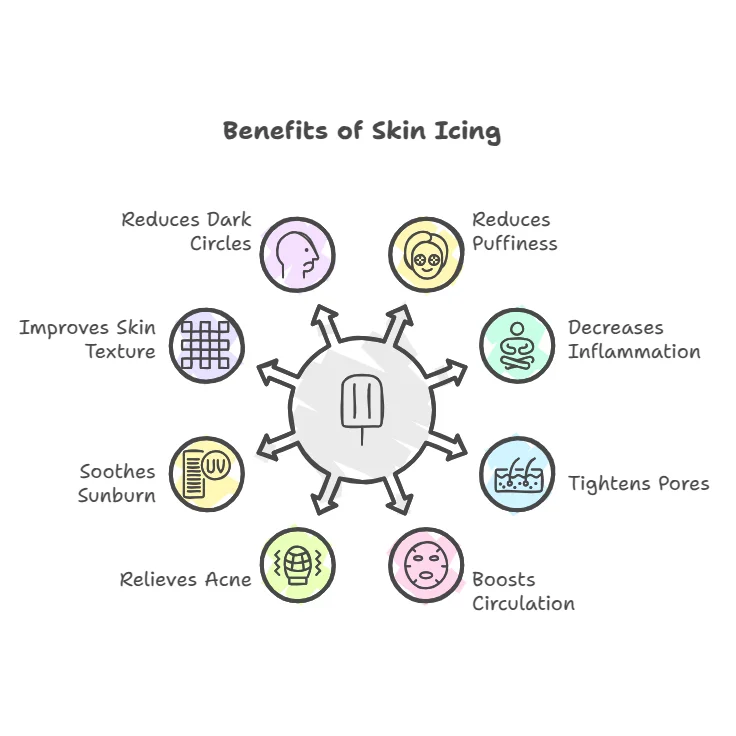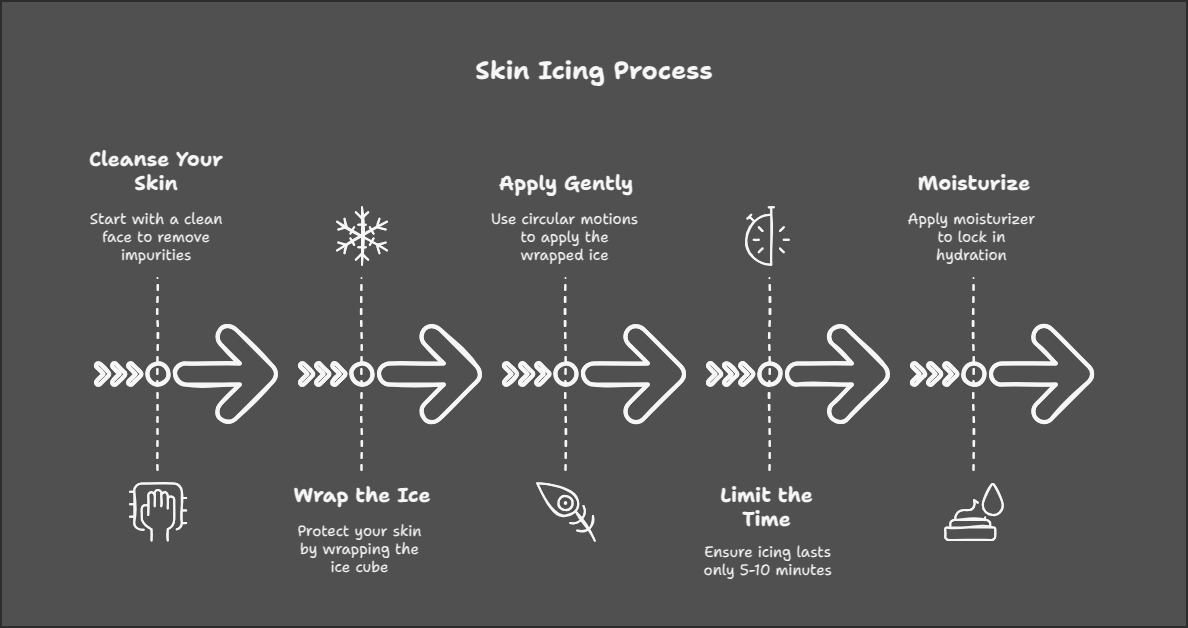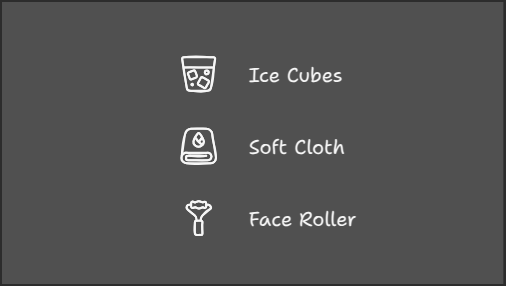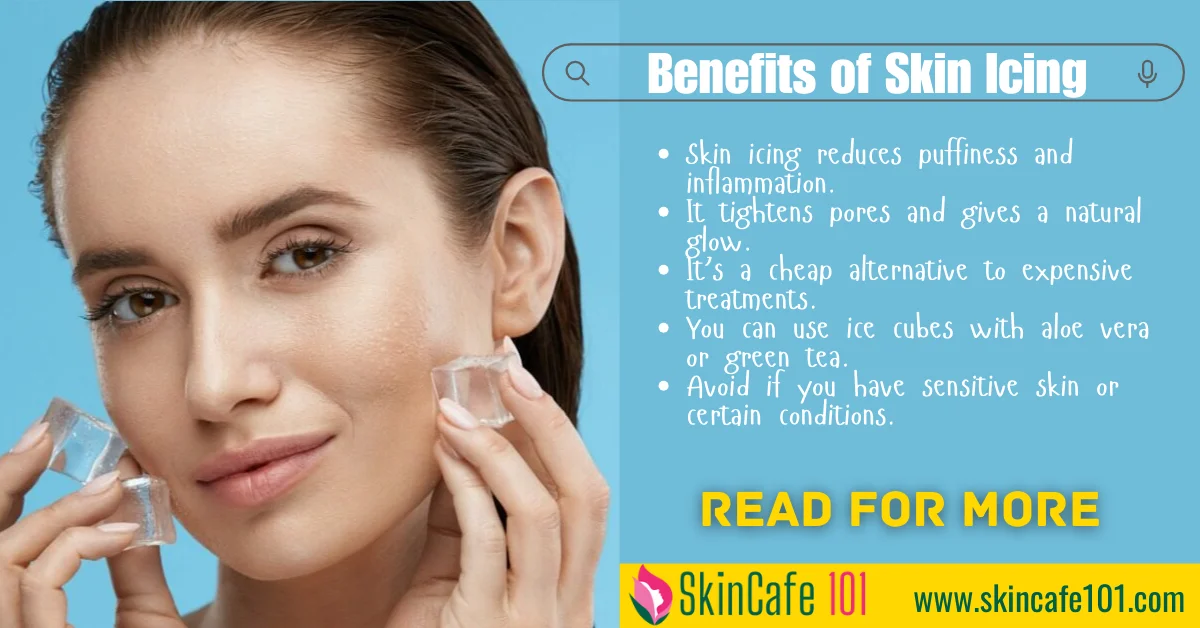Skin icing is one of those skincare hacks that feels almost too simple to be true. But here’s the thing—it works. Whether you’re dealing with puffiness, redness, or just want a quick way to wake up your skin, a little ice can go a long way. This easy, budget-friendly method has been around for ages, and it’s making a big comeback thanks to social media. So, if you’re curious about the benefits of skin icing, keep reading. We’ve got the scoop on why it’s worth a try.
Basics of Skin Icing
What Is Skin Icing?
Skin icing is the simple act of applying ice or something cold directly to your skin. It’s not just a random beauty hack—it’s a method that’s been around for ages to keep skin looking fresh and healthy. The cold temperature helps tighten your skin, minimize puffiness, and even reduce redness. Think of it as giving your skin a quick wake-up call. You don’t need fancy tools; even an ice cube wrapped in a cloth can do the trick.
The History of Skin Icing
Did you know this isn’t some new trend? Skin icing has roots going back centuries. Cleopatra, the queen of beauty herself, was said to have used ice on her face to maintain her glow. Over time, different cultures picked it up, from the chilly spa treatments in Nordic countries to the beauty rituals of ancient China. It’s proof that sometimes the old-school methods really are the best.
The Science Behind Skin Icing
So, how does it actually work? When you apply something cold to your skin, it causes your blood vessels to constrict, which can instantly reduce swelling and redness. Once you take the ice off, your blood vessels dilate, bringing a rush of oxygen and nutrients to the area. This process can leave your skin looking brighter and feeling smoother. Plus, it’s a natural way to calm inflammation—no chemicals, just ice. You can even use an ice cube massage to target puffiness, especially around the eyes.
10 Benefits of Skin Icing
The benefits of icing your skin go beyond just cooling you down on a hot day. This easy practice can improve the overall health and appearance of your skin in many ways. Here’s a look at 10 key benefits of skin icing that you might want to add to your skincare routine.

1. Reduces Puffiness
One of the most immediate benefits of skin icing is the reduction of puffiness, particularly around the eyes. Whether it’s from lack of sleep, allergies, or just waking up, icing your face can help reduce swelling and puffiness, giving your face a refreshed, rejuvenated look. Simply glide an ice cube gently over your skin to see a noticeable difference.
2. Decreases Inflammation
If you have irritated or inflamed skin, skin icing can provide instant relief. The cold helps to calm and constrict blood vessels, reducing redness and irritation. Whether you’re dealing with an acne breakout or skin sensitivity, the cooling effect will help soothe inflammation and promote a healthier complexion.
3. Tightens Pores
Another fantastic benefit of skin icing is its ability to tighten pores. The cold temperature constricts the skin, making pores appear smaller and less noticeable. This can lead to smoother, more even skin that feels firmer and tighter, making it a perfect step before applying makeup for a flawless finish.
4. Boosts Circulation
Skin icing stimulates circulation, which can result in a more radiant and glowing complexion. The cold temperature constricts blood vessels, and as your skin warms back up, blood flow increases, bringing nutrients and oxygen to the skin. This process can enhance your skin’s overall health, giving you a natural, healthy glow.
5. Relieves Acne
Dealing with acne can be frustrating, but skin icing can help reduce inflammation and redness around breakouts. The cold from the ice cubes works as an anti-inflammatory, soothing your skin and helping to calm angry pimples. Icing can also slow down oil production, which can help prevent new breakouts from forming.
6. Soothes Sunburn
If you’ve had too much fun in the sun and ended up with a mild sunburn, skin icing can provide instant relief. The cooling sensation helps reduce the heat and discomfort caused by sunburn, while also reducing redness. Just make sure to wrap the ice in a cloth or use ice cubes to avoid direct contact with the skin.
7. Improves Skin Texture
Regular use of skin icing can help improve your skin’s texture over time. It works by promoting blood flow and increasing the absorption of nutrients into the skin. As a result, your skin will look smoother and more even, with a healthier, softer feel. It’s an excellent way to achieve that coveted smooth complexion without the need for expensive treatments.
8. Reduces Dark Circles
Dark circles under the eyes can make you look tired and worn out. Skin icing can help reduce the appearance of dark circles by boosting circulation and reducing puffiness. The cooling sensation constricts blood vessels under the eyes, helping to minimize the appearance of dark shadows and make your eyes look more awake and refreshed.
9. Enhances Product Absorption
When you ice your face, it temporarily tightens your pores, which helps to better absorb skincare products. After icing, your skin will be in an optimal state to soak up the nutrients from your serums, moisturizers, and other skincare treatments, allowing them to penetrate deeper and work more effectively.
10. Improves Skin Tone
Last but certainly not least, skin icing can help balance and even out your skin tone. By stimulating circulation and reducing inflammation, the practice can promote a healthier complexion, leading to more uniform skin tone and texture. If you struggle with redness or blotchiness, skin icing can help calm those areas and leave your skin looking more balanced and radiant.
How to Incorporate Skin Icing Into Your Routine
Step-by-Step Guide to Skin Icing
Getting started with skin icing is easy and doesn’t require much. Here’s a simple guide to follow:
- Cleanse Your Skin: Always begin with a clean face. Wash off any makeup, dirt, or oil to ensure the ice can work directly on your skin.
- Wrap the Ice: Take an ice cube and wrap it in a soft, clean cloth or tissue. Direct contact with ice can irritate or even damage your skin.
- Apply Gently: Rub the wrapped ice cube over your face in small, circular motions. Focus on areas prone to puffiness or redness, like under your eyes or around your cheeks.
- Limit the Time: Keep icing to 5-10 minutes. Overdoing it can lead to numbness or frostbite.
- Moisturize: Once done, pat your face dry and apply a moisturizer to lock in hydration. This step is key to sealing the benefits of icing.

Best Times to Ice Your Skin
Timing matters when it comes to skin icing. Here are some suggestions:
- Morning: Start your day with a refreshing ice session to reduce puffiness and wake up your skin.
- Before Makeup: Icing before applying makeup can help minimize pores and create a smoother base.
- After Sun Exposure: If you’ve been out in the sun, icing can provide soothing relief for overheated skin.
Essential Tools for Skin Icing
While skin icing doesn’t demand fancy equipment, a few items can make the process more effective:

- Ice Cubes: Plain water works, but you can also use frozen green tea or aloe vera for added benefits.
- Soft Cloth or Pouch: To wrap the ice and protect your skin.
- Face Roller: If you prefer a mess-free option, a chilled jade roller or similar tool can mimic the effects of ice.
Skin icing is a simple, budget-friendly addition to your skincare routine. It’s not just effective—it’s refreshing, too!
Creative Ways to Enhance Your Skin Icing Experience
Using Aloe-Infused Ice Cubes
Why stick to plain water when you can freeze aloe vera gel into ice cubes? Aloe-infused ice cubes are a game-changer, especially for irritated or sunburned skin. The cooling effect of ice combined with aloe’s soothing properties can work wonders. Simply pour pure aloe vera gel into an ice tray, freeze, and use as needed. It’s like giving your skin a mini spa day!
Green Tea Ice for Added Benefits
Green tea is loaded with antioxidants, and when frozen into cubes, it offers a refreshing twist to your skin icing routine. Brew a strong cup of green tea, let it cool, and freeze it into ice cubes. These cubes can help reduce redness, calm inflammation, and even fight free radicals that contribute to aging.
Customizing Ice Cubes with Natural Ingredients
Why not get creative and customize your ice cubes with natural ingredients? Here are a few ideas to try:
- Cucumber Juice: Perfect for hydration and reducing puffiness.
- Rose Water: Adds a touch of luxury and helps with toning.
- Lemon Water: Great for brightening the skin, but use sparingly to avoid irritation.
Mix and match these ingredients to create your own skincare cocktail. Just make sure to patch test first to avoid any adverse reactions.
Pro tip: Keep your customized ice cubes in a labeled freezer bag so you can easily grab the one you need for a specific skin concern.
Skin Icing for Specific Skin Concerns
Combatting Acne and Blemishes
Skin icing can be a lifesaver when dealing with acne and blemishes. The cold temperature helps reduce redness and swelling, which can make pimples appear less noticeable. It also constricts blood vessels, which may slow down the production of excess oil. For best results, focus on inflamed areas for a few minutes at a time, but don’t overdo it—too much cold can irritate the skin.
Soothing Sunburns and Irritation
After a day in the sun, skin icing can provide immediate relief. The cooling effect calms irritated skin and reduces the burning sensation associated with sunburn. Wrap ice cubes in a soft cloth and gently press them onto the affected areas. This simple step can help minimize peeling and speed up recovery. Combine with soothing ingredients like aloe vera for an extra layer of comfort.
Reducing Under-Eye Bags
Tired of waking up to puffy eyes? Skin icing works wonders for reducing under-eye bags. The cold stimulates lymphatic drainage, helping to reduce fluid buildup in this delicate area. Use ice cubes wrapped in a cloth and lightly press them under your eyes for about 2-3 minutes. Adding green tea-infused ice cubes can provide additional anti-inflammatory benefits.
Precautions and Safety Tips for Skin Icing
Who Should Avoid Skin Icing?
While skin icing can work wonders for many, it’s not for everyone. People with sensitive skin or conditions like rosacea should steer clear, as the cold can worsen redness or irritation. If you’ve recently had any facial treatments—think chemical peels or laser therapy—it’s best to skip the ice to let your skin heal properly. Also, if you have broken capillaries or visible red lines on your face, icing might aggravate the issue.
How to Prevent Skin Damage
Icing your skin might seem simple, but there are a few rules to follow to avoid harm:
- Never apply ice directly to your skin—always wrap it in a clean cloth or tissue.
- Limit your icing sessions to 5–10 minutes at a time. Prolonged exposure can lead to frostbite or numbness.
- Use gentle pressure when massaging ice on your face. Pressing too hard could irritate your skin.
A quick tip: Whole ice cubes are better than broken ones, which can have sharp edges that might scratch your skin.
Signs You’re Overdoing It
It’s easy to get carried away, but over-icing can backfire. Watch out for these signs that you’re overdoing it:
- Persistent redness or irritation that doesn’t fade after a few minutes.
- A tingling or burning sensation during or after icing.
- Skin that feels overly dry or tight post-session.
If you notice any of these signs, cut back on your icing routine or take a break entirely.
Pro Tip: Listen to your skin. If it feels uncomfortable, stop immediately. Skin icing should be soothing, not painful.
Taking these precautions ensures you enjoy the benefits of skin icing without the risks. It’s all about balance!
The Role of Skin Icing in Anti-Aging
Boosting Collagen Production
Collagen is like the scaffolding of your skin—it keeps everything firm and smooth. When you apply ice to your face, the cold temperature causes blood vessels to constrict. As your skin warms back up, blood flow increases, delivering oxygen and nutrients to the area. This process can help stimulate collagen production over time. More collagen means fewer wrinkles and firmer skin. It’s a simple way to give your skin that extra support it needs as you age.
Improving Skin Elasticity
Elasticity is what makes your skin bounce back instead of sag. Over time, this natural ability decreases, but skin icing can help. The cold therapy tightens the skin temporarily, giving it a firmer appearance. Regular icing can enhance this effect, making your skin feel more resilient. Pair this with a good moisturizer, and you’re setting yourself up for skin that looks and feels youthful.
Reducing Fine Lines
Fine lines are one of the first signs of aging, and while they’re completely normal, they can be minimized. Skin icing works by tightening the skin and reducing puffiness, which can make those tiny lines appear less noticeable. Plus, the increased blood flow from icing helps nourish the skin, keeping it hydrated and smooth. It’s a quick, budget-friendly way to tackle those early signs of aging.
If you’re looking for a natural, low-cost anti-aging solution, skin icing might just be your secret weapon. It’s easy, effective, and doesn’t require fancy tools or expensive creams.
For more advanced anti-aging benefits, consider exploring cryotherapy and ice rolling, which take the principles of skin icing to the next level by enhancing collagen production and skin firmness.
Skin Icing for Seasonal Skincare
Cooling Relief During Summer
When summer hits, the heat can wreak havoc on your skin. Excessive sweating, oil buildup, and sunburns are all too common. Skin icing during summer provides instant cooling relief and helps reduce inflammation caused by sun exposure. It’s a quick way to calm your skin after a long day in the sun. Plus, it minimizes redness and can even prevent heat-induced breakouts. To take it up a notch, try using ice cubes made from soothing green tea for added anti-inflammatory benefits.
Combating Dryness in Winter
Winter brings its own set of challenges, like dryness and flakiness. Skin icing might seem counterintuitive in the cold months, but it works wonders to lock in hydration. By sealing your pores after applying a rich moisturizer, it prevents moisture loss and keeps your skin feeling soft. Another perk? It promotes blood circulation, giving your face a natural, rosy glow—perfect for combating that dull winter complexion.
Adapting Skin Icing for Different Climates
Not all climates are created equal, and your skin reacts differently depending on where you are. In humid regions, skin icing can help control excess oil and keep your face feeling fresh. In drier climates, it’s best to pair icing with a hydrating serum or cream to avoid over-drying your skin. The key is to listen to your skin’s needs and adjust your routine accordingly.
No matter the season, skin icing is a versatile and budget-friendly way to maintain healthy, glowing skin. Just a few minutes a day can make all the difference!
Debunking Myths About Skin Icing
Does Skin Icing Replace Skincare Products?
Some people think skin icing is a magic solution that can replace your entire skincare routine. That’s not true. While it’s great for reducing puffiness and tightening your skin temporarily, it doesn’t provide the hydration, nourishment, or protection that your regular products, like moisturizers or sunscreens, do. Think of it as a bonus step rather than a replacement.
Is Skin Icing Suitable for All Skin Types?
Not everyone’s skin reacts the same way to cold. If you have sensitive skin or conditions like rosacea, icing might actually make things worse. For others, it can be a refreshing addition to their routine. Always test it out on a small area first to see how your skin responds.
Common Misconceptions About Skin Icing
- “I need to ice my skin every day for results.” Nope. Overdoing it can lead to redness or even damage to your skin barrier. A few times a week is enough.
- “Ice cubes are the only option.” Actually, you can get creative with aloe vera or green tea ice cubes for added benefits.
- “Skin icing works immediately.” While it does give quick results for puffiness, long-term benefits like reduced inflammation take consistency.
Skin Icing as a Budget-Friendly Skincare Hack
Why Skin Icing Is Cost-Effective
Skin icing is one of the most affordable beauty treatments out there. You don’t need fancy gadgets or expensive creams—just ice cubes and a clean cloth. For those on a tight budget, this is a game-changer. Many skincare trends require pricey serums or tools, but with skin icing, your freezer becomes your best friend. Plus, you can even customize ice cubes using ingredients you already have at home, like green tea or aloe vera, for added benefits.
How to Make It a Daily Habit
- Prep in Advance: Freeze your ice cubes the night before. You can use plain water or add extras like cucumber juice or chamomile tea.
- Set a Routine: Incorporate skin icing into your morning or nighttime skincare routine. It works well after cleansing and before moisturizing.
- Keep It Simple: Don’t overthink it. Wrap the ice in a cloth and gently massage your face for 5-10 minutes.
Alternatives to Expensive Treatments
Instead of splurging on costly facials or anti-aging creams, skin icing offers a natural way to achieve similar results. Here’s a quick comparison:
| Treatment Type | Average Cost | Benefits |
|---|---|---|
| Skin Icing | Practically Free | Reduces puffiness, tightens skin, boosts glow |
| Professional Facials | $50-$150 per session | Deep cleansing, hydration |
| Anti-Aging Creams | $30-$100 per jar | Targets fine lines, moisturizes |
Skin icing proves that effective skincare doesn’t have to break the bank. With just a little effort, you can enjoy radiant skin without spending a fortune.
Wrapping It Up
So, there you have it—skin icing might just be the easiest way to give your face a little extra love. It’s quick, cheap, and doesn’t require a trip to the store for fancy products. Whether you’re looking to calm puffiness, brighten your complexion, or just wake up your skin, this simple trick has got you covered. Just remember to listen to your skin and don’t overdo it. A few minutes of chill time can go a long way. Why not give it a shot? Your skin might thank you for it.
Frequently Asked Questions
What is skin icing?
Skin icing is a simple skincare technique where you apply ice or cold objects to your skin to improve its health and appearance. It’s known for reducing puffiness, tightening pores, and giving your skin a fresh glow.
Can skin icing help with acne?
Yes, skin icing can help reduce redness and swelling caused by acne. The cold temperature calms inflamed skin and may speed up the healing process for blemishes.
How often should I ice my skin?
It’s safe to ice your skin 3-4 times a week. However, you should monitor how your skin reacts and avoid overdoing it to prevent irritation or damage.
What tools do I need for skin icing?
You can use regular ice cubes, ice rollers, or frozen face masks. For added benefits, try making ice cubes with natural ingredients like aloe vera or green tea.
Are there any risks to skin icing?
Yes, prolonged exposure to ice can cause skin damage or frostbite. Always use a cloth to wrap the ice and avoid applying it directly to your skin for too long.
Is skin icing suitable for all skin types?
While it’s generally safe, people with sensitive skin or certain conditions like rosacea should consult a dermatologist before trying skin icing.
Can I replace my skincare routine with skin icing?
No, skin icing is a great addition to your routine but not a replacement. You should still cleanse, moisturize, and use sunscreen daily.
What are some creative ways to enhance skin icing?
You can freeze ingredients like cucumber juice, green tea, or aloe vera into ice cubes for added skincare benefits while icing your face.

